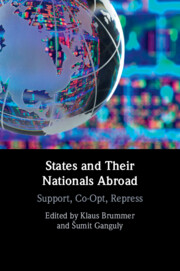Book contents
- States and Their Nationals Abroad
- States and Their Nationals Abroad
- Copyright page
- Dedication
- Contents
- Figures
- Tables
- Contributors
- 1 States’ Interactions with Their National Communities Abroad
- 2 India
- 3 Mexico
- 4 Russia
- 5 China
- 6 Pakistan
- 7 Philippines
- 8 The United Kingdom
- 9 Indonesia
- 10 Germany
- 11 Egypt
- 12 Türkiye
- 13 The United States
- 14 Comparative Insights into States’ Support, Co-optation, and Repression of Their National Communities Abroad
- Index
- References
1 - States’ Interactions with Their National Communities Abroad
Published online by Cambridge University Press: 04 December 2024
- States and Their Nationals Abroad
- States and Their Nationals Abroad
- Copyright page
- Dedication
- Contents
- Figures
- Tables
- Contributors
- 1 States’ Interactions with Their National Communities Abroad
- 2 India
- 3 Mexico
- 4 Russia
- 5 China
- 6 Pakistan
- 7 Philippines
- 8 The United Kingdom
- 9 Indonesia
- 10 Germany
- 11 Egypt
- 12 Türkiye
- 13 The United States
- 14 Comparative Insights into States’ Support, Co-optation, and Repression of Their National Communities Abroad
- Index
- References
Summary
States interact with their national communities abroad in very different ways. In some cases, they actively support and protect them. In other cases, they co-opt and exploit their national communities abroad in that they reach out to them in order to tap into, thus benefitting domestically, from their economic and financial potentials or to garner political support. In still other cases, they repress or coerce their communities abroad, thus conceiving the latter not as an asset but as a possible challenge or threat that needs to be controlled. Against this background, the chapter first explores the general motivations and objectives as to why states interact with their national communities abroad, in the form of “support,” “co-optation,” and “repression.” Then, it discusses key practices that states employ in this interaction, along three substantive dimensions, namely: diplomacy and consular, economy and social, and security. Next, possible drivers that condition whether, how, and for what reason states interact with their communities abroad are presented. This is followed by a discussion on how the countries covered in this volume were selected. The concluding section presents the plan of the book and briefly summarizes the individual chapters.
- Type
- Chapter
- Information
- States and their Nationals AbroadSupport, Co-Opt, Repress, pp. 1 - 32Publisher: Cambridge University PressPrint publication year: 2024

